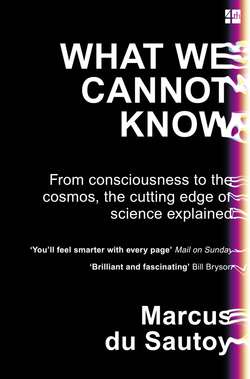Читать книгу What We Cannot Know: Explorations at the Edge of Knowledge - Marcus Sautoy du - Страница 45
IRRATIONAL EXUBERANCE
ОглавлениеThe discovery by the ancient Greeks that there were lengths that couldn’t be expressed as simple ratios of whole numbers led the mathematicians of the time to create new mathematics, the mathematics of irrational numbers, in order to truly take the measure of the universe. Other basic lengths like π, the circumference of a circle of unit diameter, also turned out to be irrational and not captured by ratios of whole numbers. Although the ancient Greeks knew 2000 years ago about the irrationality of the square root of 2, it took till the eighteenth century for Swiss mathematician Johann Heinrich Lambert to prove that no fraction could capture π.
Despite my aversion to things we cannot know, reading about numbers that can’t be captured using simple whole-number ratios or fractions was one of the defining moments that sparked my love affair with mathematics. The same year that my music teacher introduced me to the trumpet in the storeroom cupboard, my maths teacher introduced me to the proof of the irrationality of the square root of 2. The proof was contained in one of the books my maths teacher recommended to me to ignite the mathematical fire in me. It worked. I was amazed to find that you could prove with a finite logical argument that only the infinite could articulate what a length such as the diagonal across a square measured. If I couldn’t write out this length, the next best thing was knowing why I couldn’t know this number.
Since reading that proof as a schoolkid I have learnt about alternative ways to explore these irrational numbers – so perhaps these are numbers we can know. There are infinite expressions with patterns that make the number less mysterious. For example,
The discovery of these expressions pulls these irrational numbers into the known. A fraction is a number whose decimal expansion repeats itself from some point. Couldn’t I regard these expressions as a pattern, not too dissimilar from the repeating pattern of the decimal expansion of the fraction? The repeating pattern of the fraction means that there are two numbers whose ratio captures the number, while in the case of √2 and π I am resigned to needing infinitely many numbers to pin down these lengths. The question of whether something has to be finite to be known will haunt me continually throughout my journey to the frontiers of the unknown.
Of course, for any practical application of these numbers, I could probably get away with an approximation which is a fraction. Most engineers are happy to use the estimate 22⁄7 for π that Archimedes got by approximating a circle with a 96-sided figure. In fact, I need only know 39 digits of π to be able to calculate the circumference of a circle the size of the observable universe to a precision comparable to the size of a hydrogen atom. There even exists a formula that can tell me what the millionth digit of π is without calculating all the intervening digits. Not something that I’m desperate to know. But this formula will only ever give me finite knowledge of a number that necessitates the infinite to fully embrace it.
The discovery of these numbers seemed to imply an infinite divisibility of space. Only by dividing space infinitely would I be able to measure the precise dimensions of my simple cube. The discovery meant that in the West Aristotle’s continuous view of matter would remain dominant until the Renaissance.
